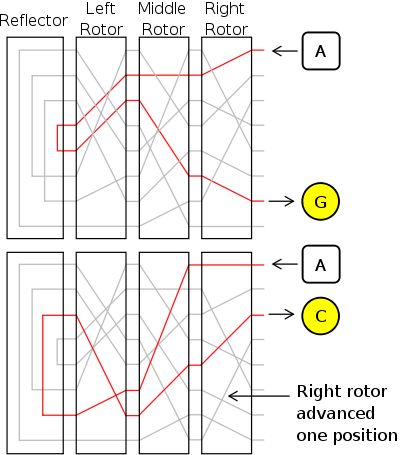Reflector (cipher machine)
A reflector, in cryptology, is a component of some rotor cipher machines, such as the Enigma machine, that sends electrical impulses that have reached it from the machine's rotors, back in reverse order through those rotors. The reflector simplified using the same machine setup for encryption and decryption, but it creates a weakness in the encryption: with a reflector the encrypted version of a given letter can never be that letter itself. That limitation aided World War II code breakers in cracking Enigma encryption. The comparable WW II U.S. cipher machine, SIGABA, did not include a reflector.

The scrambling action of the Enigma rotors shown for two consecutive letters — current is passed into set of rotors, around the reflector, and back out through the rotors again.
Note: The greyed-out lines represent other possible circuits within each rotor, which are hard-wired to contacts on each rotor.
Letter A encrypts differently with consecutive key presses, first to G, and then to C. This is because the right hand rotor has stepped, sending the signal on a completely different route.
Other names
The reflector is also known as the reversing drum or, from the German, the Umkehrwalze or UKW.
gollark: Wow. Huh.
gollark: Wait, is it ACTUALLY negative?
gollark: To be really evil, divide the upvotes or whatever by investments.
gollark: Interesting idea.
gollark: Yes, crazy memeeconomy brokenness is broken.
This article is issued from Wikipedia. The text is licensed under Creative Commons - Attribution - Sharealike. Additional terms may apply for the media files.